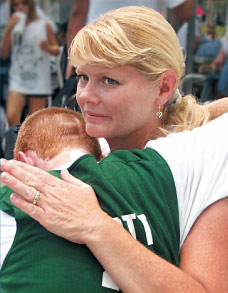Accidental Tooth Loss
Saving a displaced tooth resulting from an accident
Dear Doctor,
My son Ryan, was playing in a Little League Baseball game and he was hit on the mouth with the baseball. His tooth was knocked out and we had a hard time finding the tooth. When we did find it we really didn't know what to do. We went to the hospital and they had to call a dentist to come to treat my son. He was concerned because he said we didn't know how to handle the tooth properly. What would have been the best thing do do in this situation?

Dear Jennifer,
Handling this kind of accident properly and promptly is critical to saving the tooth. This type of accident is more common than you would think. As many as one out of three boys and one of four girls will have suffered a traumatic dental injury before they graduate high school. Sports participation can boost a child's risk, however teens and young adults can also injure their teeth in car accidents and falls.
Accidents can result in nothing more than a chipped tooth or can cause severe head trauma. Luckily, few dental injuries are true emergencies — but it is important to note that all dental injuries require professional care. The first step is to determine the extent of injury and then to take appropriate action. Parents, teachers, coaches, and school nurses should all be aware of the kinds of dental injuries that call for immediate attention.
A tooth that is knocked out of a person's mouth is called an avulsed tooth. Time is of the essence in this situation, re-implanting the tooth as quickly as possible allows the best chance of the tooth being re-accepted and therefore complete healing. Certain other steps can make re-implantation more likely.
Responding to a “Lost” Tooth
First things first: If a lost tooth is truly missing, it's important to locate the tooth right away. If you didn't witness the accident, try to find out when and exactly where it happened. These details are important because a tooth that has been out of the mouth for less than 30 minutes has the best chance for re-implanting. A tooth that might be at the bottom of a swimming pool has a better outlook than one that has landed in a puddle of oil or gasoline from a car accident.
Once the tooth has been located, use nothing other than cold water to carefully remove any dirt or debris. Simply run or pour the water over the tooth — do not touch the root or scrub any part of the tooth, and do not use soap or other cleansers. If no running water is available, you can put the tooth in your mouth and gently suck it clean. Then delicately place the tooth back into the injured person's empty socket and have them hold it in place until they reach the dental office.
Handling the Isolated Avulsed Tooth
Sometimes a lost tooth cannot be immediately reinserted into the socket for some reason (for example, if the injured person is unconscious and may be in danger of choking on or swallowing the tooth). In this instance, the tooth must be transported to the dental office or hospital in a moist environment via a separate container. The success of re-implantation depends on keeping special ligament cells on the root's surface moist and alive — if these cells dry out, they will die and the tooth will not be accepted back into the gums.
Cold milk is one of the best liquids in which to (temporarily) store an avulsed tooth; sterile saline solution is another excellent option. Placing the tooth in the injured person's mouth, bathed in his or her own saliva, is actually a second choice, but still better than allowing the tooth to dry out. Wrapping the tooth in plastic wrap to seal in moisture is a third choice.
Following Re-implantation
If the right steps are taken, chances of a successful re-implantation are good. After the procedure, there is the possibility of infection, so a short course of antibiotics is usually prescribed. Even with the best response, however, a lost tooth may still be rejected by the body down the road. If there had been any damage to the ligament cells, the body may begin to wear away the root surface, gradually destroying it (this is called “root resorption”) and causing loss of the tooth. To monitor for this condition, the patient should follow up with their dentist for at least five years following re-implantation of a lost tooth.
A re-implanted tooth may also eventually be damaged by a process called ankylosis. This condition causes the root of the tooth to actually fuse to the supporting jawbone beneath it, without any healthy ligament in between. Ankylosis can also lead to resorption and tooth loss.
Always Give it a Try
It would have been nice for Ryan to save the ball game and his tooth. In summary, quickly locate a lost tooth after the accident, rinse the tooth with ice water, and gently re-implant it if you can, on the way to the local dental office or hospital. Making a call to the dentist or hospital en route ensures that the doctor can meet you there, thereby creating the best possible situation.
Even in less than ideal situations, tooth re-implantation can work and should always be attempted. Saving a natural tooth is definitely the treatment of choice.



